
J. West Adds Entertainment, Technology into Weatherization Training
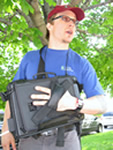 |
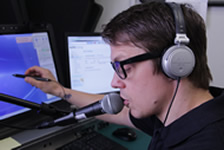 |
When J. West begins a training session, he pulls from his experiences as a rugby player and singer in a metal band. |
“It’s all about figuring out why your amp won’t start while wondering where the bass player is,” he says.
These days J. is a training specialist with the Community and Economic Development Association of Cook County (CEDA). With a 19th-floor office in downtown Chicago, CEDA is the largest weatherization company in the United States. CEDA has its own weatherization training department that conducts training online, in the field, and in classrooms or labs. Some of those classes are taught at Wilbur Wright Community College.
Even though J. has retired from touring, he still engages his audiences. He believes there needs to be “a certain level of entertainment in adult education.”
“Technology provides us with more ways to customize and personalize our training,” says J., who has gained a reputation for keeping students’ attention through his energetic and dynamic style of delivery.
J. states that technology should be used to blur the line between classroom and field training. One of J.’s favorite ways do this is Dale Sherman’s Projected Overlay Presentation method. J. uses his laptop computer to project PowerPoint or Prezi overlays onto static equipment and explain the operation and interaction of each component. In other exercises, students watch remotely as inspectors crawl into attic cavities. The inspectors wear head cameras so students can observe the activity via an Internet connection.
Frequently J. and the CEDA Weatherization Training Department “flip the classroom.” In a flipped classroom, students absorb course material—like recorded presentations and instructional videos—before coming to class. J. explains that this approach allows students to uptake information at their own speed. When the class comes together as a group, J. can spend the majority of the time applying and discussing the course materials.
“They call it ‘flipping’ because the work ordinarily done in the classroom becomes the homework and the work ordinarily done at home becomes the classroom work,” he says.
“I try to make a comfortable environment for students,” J. says, adding “Technology helps make it fun and easy to remember.”
“My specialty is training trainers,” he says about his energy auditor, contracting, and quality control inspector courses. In a way, he sees himself as a coach. He picked up coaching skills during his years as a scrum half on rugby teams in Chicago, Buenos Aires, London, and Durban, South Africa.
J., who hails from Kankakee, a river town south of Chicago, earned two bachelor’s degrees at Illinois State University’s School of Sociology. More recently he worked as a private contractor doing restoration work on windows in historic structures.
“I have only been a trainer in weatherization for about four years, but it feels like I have been doing it for 100 years. I went to all the trainings and conferences I could. That’s where I developed my passion for instructional design and adult learning. I use those principles every single day,” he says. He learned the fundamentals of instructional design at classes sponsored by the U.S. Department of Energy and delivered by the Oak Ridge Institute for Science and Education (ORISE).
“He has that ‘more than an instructor’ presence. You feel his energy and sincerity about teaching,” says Sam Daugherty, Instructional Design Specialist, ORISE.
“The training made a big difference—a huge difference. It helped turn the knowledge and skills I had into the ability to motivate learning. Before, I was doing education. Now my focus is on learning,” J. explains. “I’m happy doing what I’m doing.”
Home Energy Audits: Two Viewpoints
 |
When Jeff Patterson goes out to do a home energy audit, he can be certain of one thing. |
Inc., in Jasper, Georgia. “If only the installer had spent 20 more minutes to use mastic around the joints where the two pieces of metal meet,” he laments.
“In my job I serve many roles, including doing energy audits, inspections, and installations,” Mr. Patterson says. Home energy audits follow standard procedures beginning with determination of eligibility of services. Every house has individual characteristics, but it doesn’t take him long to find air leakage in the ductwork and areas in need of better insulation.
Energy audits are routine for Mr. Patterson, but he realizes they are a big event for homeowners. Energy audits help people on tight budgets because savings on energy bills can be significant. The resulting weatherization improvements also provide a more comfortable and healthier environment in the home.
What do homeowners think about energy audits? We asked two clients of North Georgia Community Action, Inc., about their impressions of the energy audits and work completed on their homes.
Angie West, a resident of Chatsworth, Georgia, knew weatherization work could improve her 23-year-old home. When Mr. Patterson conducted the energy audit, he talked to her about two areas in particular: the attic did not have adequate insulation, and the kitchen and bathroom vents did not open through the roof of the house. He noted improvements for the crawl space and gave her information sheets to read.
“He’s a swell guy. I really appreciate the time he took to explain everything,” says Ms. West. Mr. Patterson let her know when the work crew would arrive and how they would go about completing the work order. The weatherization crew completed the work in January.
“The workers were very neat and made sure I knew about everything they were going to do,” says Ms. West. “I’m really happy with the improvements. It means a whole lot to me. I’m just grateful,” she says. She expects to see savings on her energy bills.
Glenda Taylor, also of Chatsworth, Georgia, could tell a difference immediately once weatherization work was completed on her home.
“I used to have wind come in through the door. That’s stopped now,” Ms. Taylor says.
Mr. Patterson, who conducted an energy audit, gave her a clear idea of the work that needed to be done on her house, a structure built in 1987.
“He went under the floor, under the attic; he went in every space you could go into. He didn’t skip anything; he did a perfect job,” Ms. Taylor says. “Any question I had, he was able to answer it. He stood still long enough to answer it.”
Her old, dilapidated heating and air-conditioning units always caused worry because she has bronchitis and asthma. The units were replaced and cracks around floor vents were sealed to prevent dust from entering and circulating into the air.
Insulation was installed in the ceiling after all wall joints were sealed. Recessed light fixtures were covered with boxes to prevent air leakage. An energy recovery ventilation fan was placed in the hall ceiling and a hood was installed above the stove. The ground in the crawl space was covered with plastic.
“Those were the hardest workers I have ever seen. These guys knew what they were doing,” exclaims Ms. Taylor. “I am pleased with everything they did.” During the final inspection, Mr. Patterson made sure all tasks were completed and Ms. Taylor had a good understanding about how to operate and maintain the new equipment.
Mr. Patterson and his 11 crew members received training at Southface Energy Institute in Atlanta. He has a string of professional certifications including BPI certifications in building envelope, building analyst, multifamily building analyst, heating pro, and whole house air leakage control installer. He also holds a National Healthy Homes inspector certification to go with the EPA Lead Safe Renovator certification. Currently he is awaiting word on the four new Home Energy Professional Certifications offered by the U.S. Department of Energy.
Trainings Benefit WTCs Staffs
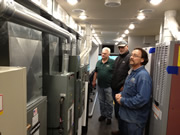 |
Bill Van der Meer, center, confers with G.H. Runevitch, COAD Training and Technical Manager, left, and James Hall, COAD Training Coordinator, in the new mobile heating lab at COAD’s Ohio Weatherization Training Center. |
Professional staff from across the country attended three training sessions sponsored by the U.S. Department of Energy (DOE) and coordinated by the Oak Ridge Institute for Science and Education (ORISE).
On January 22-25, 10 students in Michigan increased their proficiency in using the National Energy Audit Tool (NEAT) and the Manufactured Home Energy Audit (MHEA). The training was held at Focus: HOPE’s WARM Training Center in Detroit. Daniel Vida, Energy Consultant with D & R International, and Bill Van der Meer, Consultant to the U.S. Department of Energy, served as instructors.
Students collected data during field visits to two site-built homes and one mobile home. After each visit, they returned to the classroom to input data into the auditing software. In the beginning, they worked as teams, but as the training progressed they were encouraged to work independently to substantiate their own competency.
A Weatherization Training Center (WTC) Ride Along, coupled with an instructional design mini workshop, was held January 28-31 at Corporation for Ohio Appalachian Development’s Ohio Weatherization Training Center in Athens. A WTC Ride Along is an assessment tool used to strengthen the quality of training programs, build well-qualified training staffs, and improve outcomes for students.
At the WTC Ride Along, ORISE Technical Training Specialist Sam Daugherty and Mr. Van der Meer observed a refresher course for quality control inspector, taught by Steve Dillehay. They were impressed with his effective use of props and overall teaching performance. In a conference at the end of the visit, they outlined COAD’s strengths and made recommendations for improvements. The COAD staff benefited from one-on-one technical support. A 1.5-day instructional design workshop helped the staff connect learning fundamentals to actual practice.
“The instructional design workshop provided our training professionals with resources to bring our team to the next level in design, development, and delivery in training curriculum. Our team is truly excited to integrate the new tools introduced through the workshop,” says Kelly Kupcak, Workforce Program Manager, COAD.
Fourteen weatherization training professionals gathered in Indianapolis, Indiana, for a complete instructional design workshop delivered by ORISE. It was held February 4-8 at the Indiana Community Action Association training center.
“The students walked away with teaching tools that they can use right away,” says Mr. Daugherty, citing a 50-question test bank as an example. The intensive training gave students the knowledge and skills to improve the training materials and curriculum at their training centers.
“Sam drove home the foundations of instructional design, lesson plan development, test item construction, and above all—to focus everything on the learning objectives. This training is going to make me a more effective instructor and curriculum developer no matter what I do in the future,” says Jack Martin, Trainer, National Sustainable Structures Center, Williamsport, Pennsylvania.
“This was without a doubt, the single most intellectually challenging and rewarding training that I have been a part of since I started in weatherization,” says Mr. Martin.
The workshop provided information about the National Weatherization Platform, an open-source, online teaching resource that enhances and supplements traditional classroom, lab, and in-field weatherization training. Kelly Cutchin, a Weatherization Technical Advisor with Simonson Management Services, delivered the instruction on the National Platform.
Safety Tip:
Personal Carbon Monoxide Monitors
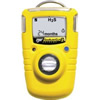 |
The National Institute for Occupational Safety and Health (NIOSH) has established a recommended exposure limit (REL) for carbon monoxide of 35 ppm. |
This instrument is capable of detecting carbon monoxide (CO) concentrations between 0 and 600 ppm.
Several types of detectors are available to screen for the presence of carbon monoxide, such as the BW Honeywell Gas Alert Clip Extreme CO Monitor (shown). These instruments are designed to clip onto clothing near the person’s breathing zone. An alarm will sound if ambient carbon monoxide meets or exceeds 35 ppm. They are single-use monitors with lifetimes of 24 or 36 months; they require no calibration, sensor replacement, battery replacement, or battery charging.
An auditor should evacuate the area when carbon monoxide levels exceed 35 ppm in ambient air. These recommended levels are consistent with the Standard Work Specifications of the Guidelines for Home Energy Professionals and the Building Performance Institute’s Building
Analyst standards.
Note: Neither NIOSH nor Occupational Safety and Health Administration (OSHA) has a recommended method for full-shift sampling of employee exposure to carbon monoxide in the workplace.
For more information, click here.
On the Horizon
Better Buildings: Better Business Conference
March 6-8, Wisconsin Dells, Wisconsin
ACEEE/CEE National Symposium on Market Transformation
March 24-26, Washington, DC
2013 ACI National Home Performance Conference
April 30-May 3, Denver, Colorado
National Energy and Utility Affordability Conference
June 10-12, San Diego, California
ACEEE Summer Study on Energy Efficiency in Industry
July 23-26, Niagara Falls, New York
American Renewable Energy Day Summit
August 15-20, Aspen, Colorado
NASEO 2013 Annual Meeting
September 15-18, Denver, Colorado
EEBA: Excellence in Building Conference and Expo
September 24-26, Phoenix, Arizona
IREC Online System Saves Time, Streamlines Application Process
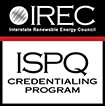 |
The Interstate Renewable Energy Council (IREC) Credentialing Management System (CMS) gives Weatherization Training Centers (WTCs) a way to |
apply for and manage their IREC credentials online. The CMS streamlines the application process and provides a one-stop place for candidates to view data related to their credential and communicate with IREC assessors and staff.
IREC released its online CMS last June. Since that time, 49 applications were submitted via the CMS. Current credential holders are managing their annual maintenance requirements using the CMS.
What are the advantages of using the CMS? WTCs like the convenience of using an online tool to manage the many documents associated with an IREC application. They also appreciate that requirements are now broken down into logical sections, depending on whether the requirement relates to the technology (i.e., Energy Auditor) or general operations of the WTCs.
“Best of all, it is paperless,” says Brian Mattiske, Application Process Manager, IREC Credentialing Program. “Eliminating paper applications saves time and cost for applicants and credential holders.” He urges applicants to save money on materials and shipping, plus benefit from the convenience of having instant access to the application file.
- Interested in starting the online application for an IREC credential? The CMS can be accessed here: https://i7lp.integral7.com/irec.
- Want to know more about the CMS or what your next steps are in the credentialing process? Click here http://www.irecusa.org/wp-content/uploads/CMS-Process.pdf to view the steps of the process and information about each step.
- To access the latest CMS Reference Guide, click here http://www.irecusa.org/wp-content/uploads/CMS-Reference-Guide.pdf.
JTA-aligned Energy Auditor Module Is Ready
Weatherization professionals will have access in early March to the updated Energy Auditor 2.0 module through the Weatherization Assistance Program Technical Assistance Center link http://www.waptac.org/Training-Tools/WAP-Standardized-Curricula.aspx.
The module has 31 chapters, including nine prerequisite chapters. It contains 13 quizzes and answer keys so instructors can conduct a knowledge check to identify learning gaps. An updated Master Bibliography offers a wealth of resources.
The Energy Auditor 2.0 module is the fourth module that has been revised and updated. The Weatherization Installer/Technician, Crew Leader, and Quality Control Inspector modules are also available in an updated 2.0 version. These resources are of high interest to the weatherization network and are provided at no cost.
The four modules align with the National Renewable Energy Laboratory Job Task Analyses (JTAs) for national worker certification. They are part of the U.S. Department of Energy’s Weatherization Assistance Program Standardized Training Curricula.
Carrie Smith Receives Award
The National Association for Community Services Program has selected Carrie Smith as the 2013 recipient of the James Gardner Weatherization Award.
Ms. Smith is Chief of In-Home Services, Foundation for Senior Living, Phoenix, Arizona.
She received this prestigious award because of her outstanding work with the Home Improvement Program and Home Care Program. The award also recognizes her contributions as a member of the Senior Leadership Team.
Trainers’ Consortium Covers Client Education
Participants on the next Trainers’ Consortium call will focus on client education. Presentations will cover how to connect with the client and develop a statewide client education training program. The call is set for 3 p.m. (EST) on Tuesday, March 5.
Now Showing on WxTV:
Smart Grid 101
Power companies are using Smart Grid technology to predict demands and get more out of the existing power generation delivery system. This episode also shows how homeowners can install energy management systems to analyze energy use and save on costs. To learn more about Smart Grid demonstration programs, visit www.wxtvonline.org.
